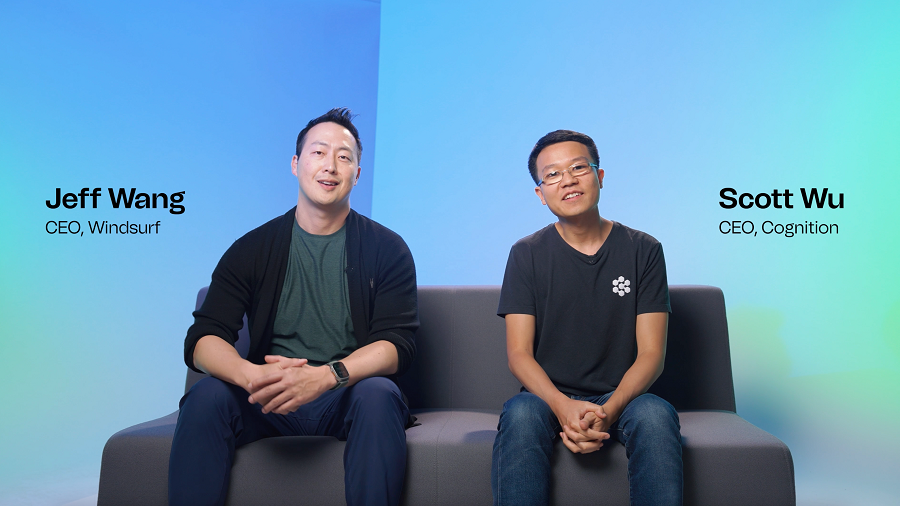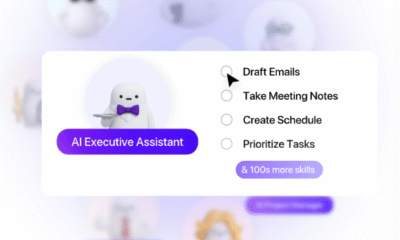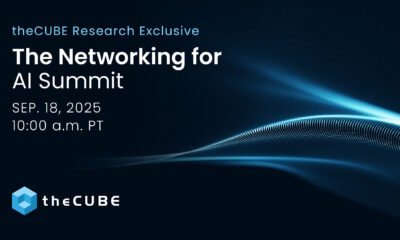Tools & Platforms
AI coding assistant startup Cognition acquires rival Windsurf

Cognition AI Inc., a well-funded startup with an artificial intelligence coding assistant, today announced plans to buy rival Windsurf.
The terms of the deal were not disclosed.
The sale caps off an eventful few months for Windsurf. The startup, which is incorporated as Exafunction Inc., reportedly received a $3 billion takeover bid from OpenAI in April. Last week, it declined the offer and instead signed a $2.3 billion technology licensing deal with Google LLC.
The deal saw Windsurf founders Varun Mohan and Douglas Chen join the search giant along with several researchers. Most of the company’s 250 staffers have reportedly remained in their roles. Jeff Wang, Windsurf’s head of business prior to the deal with Google, is now interim Chief Executive Officer.
Windsurf’s flagship product is an eponymous code editor with a built-in AI assistant. The assistant can explain how a piece of code works, generate new code and scan it for bugs. The editor also offers other features, including a tool that allows developers to quickly preview the interface of a newly created website.
San Francisco-based Cognition competes in the same market. Its flagship Devin coding assistant can automate many of the same tasks as Windsurf, as well as provide a step-by-step overview of how it completes those tasks. Developers can manually optimize those steps to enhance the AI’s output.
Cognition sells an enterprise version of Devin that includes several additional features. It provides the ability to fine-tune the assistant’s AI models using proprietary datasets, which boosts output quality. Customers can optionally deploy their customized versions of Devin on their own infrastructure.
The acquisition of Windurf comes four months after Cognition reportedly raised “hundreds of millions of dollars” in funding. According to Bloomberg, the investment doubled its valuation to $4 billion.
In a blog post, Cognition co-founder and CEO Scott Wu disclosed that Windsurf has hundreds of thousands of daily active users. That installed base base is generating $82 million in annualized sales. Windsurf’s revenue from enterprise customers, in turn, is doubling quarter-over-quarter.
“In the immediate term, the Windsurf team will continue to operate as they have been, and we will remain focused on our work of accelerating your engineering with Devin,” Wu wrote. “Over the coming months, we’ll be investing heavily in integrating Windsurf’s capabilities and unique IP into Cognition’s products.”
Windsurf relies on Anthropic PBC’s Claude series of large language models to power some of its features. After word of OpenAI’s takeover effort emerged in April, Anthropic cut access to its LLMs. Wu wrote today that Windsurf will have “full access to the latest Claude models” following its acquisition by Cognition.
Image: Cognition
Support our open free content by sharing and engaging with our content and community.
Join theCUBE Alumni Trust Network
Where Technology Leaders Connect, Share Intelligence & Create Opportunities
11.4k+
CUBE Alumni Network
C-level and Technical
Domain Experts
Connect with 11,413+ industry leaders from our network of tech and business leaders forming a unique trusted network effect.
SiliconANGLE Media is a recognized leader in digital media innovation serving innovative audiences and brands, bringing together cutting-edge technology, influential content, strategic insights and real-time audience engagement. As the parent company of SiliconANGLE, theCUBE Network, theCUBE Research, CUBE365, theCUBE AI and theCUBE SuperStudios — such as those established in Silicon Valley and the New York Stock Exchange (NYSE) — SiliconANGLE Media operates at the intersection of media, technology, and AI. .
Founded by tech visionaries John Furrier and Dave Vellante, SiliconANGLE Media has built a powerful ecosystem of industry-leading digital media brands, with a reach of 15+ million elite tech professionals. The company’s new, proprietary theCUBE AI Video cloud is breaking ground in audience interaction, leveraging theCUBEai.com neural network to help technology companies make data-driven decisions and stay at the forefront of industry conversations.
Tools & Platforms
‘AI will not love you, AI will not cry with you’: COICOM panel warns Church of technology’s limits

Artificial intelligence is no longer a distant concept for the Church but a pressing reality that demands attention. That was the message of a panel at the 2025 Congress of the Ibero-American Confederation of Communicators, Pastors, and Christian Leaders (COICOM) held in Honduras last week, where ministry and technology experts explored both the promise and perils of AI for faith communities.
Moderated by COICOM president Arnold Enns, the session—titled “Artificial Intelligence: Challenges and Opportunities for the Church”—brought together Vladimir Lugo, Steve Cordon, and Fabio Criales. The panelists examined the nature of AI, its societal impact, and its growing yet inescapable role within Christian ministry.
The discussion began with definitions. Lugo described AI as a branch of computing that “allows machines to do things that were previously reserved for humans,” including learning, analyzing, and making decisions. He clarified that AI does not reside in a single place but operates on vast cloud servers controlled by global tech giants such as Google, Amazon, and Microsoft, each competing for dominance in the field.
The dilemma of control and inherent bias
One of the first concerns raised was the issue of control and ethics. Panelists emphasized that AI technologies are not neutral. Lugo warned that publicly available models “carry biases,” reflecting the agendas of the secular companies that train them.
“Many of these companies are woke,” he said, arguing that they promote “anti-biblical” values and that their AI creations reflect humanist and liberal ideologies.
Criales added that AI “was meant to make evident what is already present” in the human heart, citing Matthew 15:18-19. He also cautioned about the danger of “hallucination”—when AI generates incorrect or misleading information in response to poorly framed prompts.
“Be very careful with that, because it hallucinates, recreates what you ask, and if you ask incorrectly, you could end up saying heresies on stage,” Criales warned.
Digital consumers or disciples?
The panel also weighed AI’s influence on ministry content creation. With more pastors turning to tools like ChatGPT to write sermons, Lugo acknowledged that AI can be a useful “tool” for research. But he stressed that “the intelligent entity using the tool is the human” and cautioned against surrendering discernment.
Cordon posed a sharper question about the widespread adoption of AI-driven platforms, noting the 123 million daily users of ChatGPT: “Have we created more digital consumers than digital disciples?” True pastoral work, he said, cannot be automated. “People need pastors. AI will not love you, AI will not cry with you.”
He recounted a sobering personal experience with a counseling AI that not only conversed smoothly but also offered to pray for him in eloquent, detailed language. The moment highlighted for him the unsettling boundary between authentic pastoral care and technological simulation. “I believe AI will also be a test of maturity for the Church,” he reflected.
A call for training and responsibility
The panel closed with a strong call for Christian leaders to equip themselves and their congregations to engage AI critically. “Either you use it, or it uses you—there really isn’t an alternative,” Cordon said.
Criales stressed that believers must be intentional in learning how to apply these tools properly. Lugo concluded with an appeal to humility: “If there is anything we want to learn from the Lord, let us learn how to learn.”
The consensus was clear: artificial intelligence is not merely a technological development but a spiritual test. For the Church, it represents a challenge requiring maturity, ethical discernment, and above all, a reaffirmation of the irreplaceable value of human connection in ministry.
Originally published on Diario Cristiano, Christian Daily International’s Spanish edition.
Tools & Platforms
MSP evolution in the age of AI and risk – ARN

Embracing consultative models
This bodes well for the right IT channel partners. Shoer said partners have to really embrace a more consultative model; they can’t look at an AI tool in the traditional mindset of just making money.
“What they really need to do [is] understand what the customer is trying to achieve and is AI the right tool to help them achieve that?” he said. “It may be part of a broader tool set, or it may be part of a change in business process.
“It could be any one of a number of things [and] they also have to be mindful of the pressure to assist a customer they’ve addressed their own environment and how they’re using AI.”
Shoer noted the GTIA has been conservative in its own use of AI and how its leveraging it internally.
“We’re doing an internal case study on ourselves to try and learn where gaps and pitfalls may be so that we can help inform our members what they need to be looking at, first and foremost, in their own business before they go out and try and sell themselves,” he explained.
The temptation to go out and sell themselves as an AI expert is massive right now, noted Shoer.
One of the most important areas with AI right now is looking at agreements. With the rush to AI, the message of going slow is getting lost.
When he was at GTIA’s ChannelCon conference, Shoer said there was only “one MSP in the room that was actually selling — truly selling — AI services”.
“His message to the attendees was, ‘Don’t rush in, because you could destroy your business if you move in too fast’… it’s more important than ever,’” he pointed out. “There have been so many cycles where people have jumped on and represented themselves as an MSSP [managed security service provider] — when they really weren’t an MSSP and skirted some delicate liability issues.
“But AI brings is a whole new dynamic to that many companies are leaking their IP out into these large models, and they don’t even know that they’re doing it.”
Want for change
End-customers in general need their technology partners to be advisory led and “to actually help their businesses,” said The TSP Advisory chief strategy officer James Davis.
“There’s always going to be a client base that want to be transactional,” he said. “But that level of advisory is going to scale up and down based on maturity of the client, the industry, the size, the objectives; there’s no one-size-fits-all right answer.
“But partners need direction and someone to lead them, because technology in general is too complicated.”
Davis said it’s easy to jump on and buy something, but complexity comes in when they start looking at it from a business perspective like managing costs, efficiencies, and managing risk.
“That’s when a tech partner is actually needed and where they realise where sit in the food chain,” he noted. “They need to act how they want to be treated.
Even if as an MSP, all it’s done is fixed-price support and they’re not proactively talking to their clients, said Davis.
“They’re pretty much just trying to limit as much noise as possible,” he said. “That, in itself, is a dead and dying model, because that’s not what’s necessary in a modern client ICT environment.”
For example, in an infrastructure where customers need help with applications, traditional MSPs don’t have the necessary experience.
“MSPs have always trained the clients, in general, to not come and talk to them about applications, because they can’t recommend anything,” said Davis. “A lot of clients won’t even come to the partners and ask for a lot of things, because they don’t think it’s what the partners do.”
Those partners that understand the need to help the customers on a business level “see the bigger picture” for them, he noted.
“They actually understand how the space works, because that’s where we all build our businesses, and that’s what we do all day, every day,” explained Davis. “This causes friction with partners who call themselves specialists but aren’t true specialists.
“They’re actually more the modern TSP [technology service provider], and they’re just leveraging AI to get in. That’s where they can legitimately take a lot of this business away from partners as well.”
According to Davis, the more modern, next generation technology partners that get it know they need to partner with others to ensure the customer gets the best out of them.
That’s all part of the consultative approach to ensuring the customer gets the right strategic advice.
“[Having] baseline relationships, providing some proactive advice, but really working operationally isn’t giving business or strategic advice,” he said. “You understand their business. For a partnership to work, you need to know where the organisation’s people fit in, what the business is trying to achieve, and then how the MSP is going to help the customer as a tech partner.”
Adding value
Dicker Data general manager of Microsoft Cloud A/NZ Sarah Loiterton told ARN value conversations should link technology investments to measurable business outcomes.
This includes reduced downtime, faster recovery, or improved compliance posture. She goes a step further and advises on the use of metrics like mean time to repair/resolve/respond/recover, total cost of ownership, and payback periods to illustrate impact in clear, financial terms.
“Industry‑specific insights and tailored collateral can support these discussions,” she said. “But the emphasis should remain on quantifiable benefits and risk reduction that resonate with both business and technical stakeholders.”
Partners should also start by understanding their own service identity, noted Loiterton.
For example, what they offer, where you draw the line, and which frameworks and align with, like the Australian Signals Directorate’s Essential Eight framework. Then, map these capabilities to each customer’s industry context, even when regulation is light.
Transparency is key, particularly with a clear outline on what risks can be mitigated and what contingency plans exist for residual risk.
“To accelerate this process, leverage tools that help benchmark against industry standards and legislative requirements, and translate those into actionable strategies for customers,” said Loiterton. “This ensures conversations remain sector‑specific, risk‑aware, and outcome‑focused.
When it comes to AI, having a deep understanding of governance and compliance requirements for each vertical.
“While many data protection principles are consistent, the nuances matter, especially for customer trust,” she said. “Establish clear policies for data classification, access control, and auditability.
“Incorporate human oversight into AI workflows and maintain transparent documentation of model usage and decision points. These steps demonstrate accountability and align AI initiatives with recognised governance standards.”
Loiterton also said distribution partnerships can bridge capability gaps by providing access to specialised expertise, managed services, and automation that let MSPs deliver enterprise‑grade outcomes without expanding headcount.
“Crucially, engage your distributor early on the entire scope of the customer’s requirement, not just the core workload, so they can help design whole‑of‑environment solutions,” she said. “That means validating dependencies across identity, devices, networks, data, applications, cloud/hybrid/edge, resilience/backup, observability, and governance.
“Taking a full‑scope view up‑front reduces integration gaps, speeds implementation, and ensures consistent policy and control coverage end‑to‑end.”
Collaborative models, such as co‑managed securities operations centre services, automated device management, and pre‑built AI workloads allow partners to scale efficiently while focusing internal teams on higher‑value activities.
“Clear SLAs (service level agreements), a documented RACI [framework], and shared accountability frameworks then keep service quality consistent across multiple customers,” she added.
Tools & Platforms
Chinese Tech Giants Leverage AI for User Addiction and Global Influence

In the bustling tech hubs of Shenzhen and Beijing, Chinese companies are redefining user engagement through sophisticated algorithms and behavioral nudges that keep consumers scrolling, shopping, and interacting far longer than intended. Firms like ByteDance, Tencent, and Alibaba have mastered the art of blending entertainment, social features, and commerce into seamless experiences, turning casual app use into habitual routines. This approach, often powered by artificial intelligence, analyzes user data in real-time to deliver personalized content that exploits psychological triggers like dopamine hits from notifications and endless feeds.
These strategies extend beyond mere convenience, embedding gamification elements such as rewards, streaks, and social comparisons to foster dependency. For instance, apps like Douyin—TikTok’s Chinese counterpart—use short-form videos optimized for maximum retention, with algorithms that predict and serve content to prolong sessions. According to a report from Business Insider, this “cracked code” involves proprietary AI models that adapt to individual preferences faster than Western competitors, leading to average daily usage times that eclipse those of platforms like Instagram or YouTube.
Algorithmic Mastery and Behavioral Hooks
The core of these tactics lies in data-driven personalization, where Chinese tech giants leverage vast troves of user information to refine engagement loops. Tencent’s WeChat, for example, integrates messaging, payments, and mini-programs into a super-app ecosystem, creating a “walled garden” where users rarely need to leave. This integration not only boosts time spent but also encourages micro-transactions, blurring the lines between leisure and commerce. Recent posts on X highlight how these apps blend social networking with e-commerce, with one influential investor noting that Chinese platforms like Xiaohongshu engineer addiction by seamlessly merging entertainment and shopping, outpacing ad-focused Western models.
Moreover, emerging technologies like AI-powered virtual reality and augmented reality are amplifying these effects. A study from The Arise Society warns of rising addictions in 2025, pointing to Chinese innovations in AI relationships and VR that shape behaviors and relationships, potentially leading to over-reliance on digital interactions. In China, where 5G infrastructure supports immersive experiences, companies are pushing boundaries with features that reward prolonged immersion, such as virtual rewards in games like Genshin Impact from miHoYo.
Global Implications and Regulatory Scrutiny
As these strategies go global, they raise concerns about technology addiction worldwide. Chinese firms are exporting their models through apps like TikTok, which has billions of users addicted to its algorithmically curated content. A Brookings Institution analysis in Global China: Technology examines how China’s technological reach influences user habits abroad, often through subtle data collection that refines addiction mechanics. This has prompted backlash; U.S. policymakers, as detailed in a Carnegie Endowment report on Managing the Risks of China’s Access to U.S. Data, are advocating for frameworks to counter risks from Chinese software and connected devices that could manipulate user behavior.
Yet, within China, the government balances innovation with control. The “Made in China 2025” initiative, as critiqued in a Council on Foreign Relations backgrounder on Is ‘Made in China 2025’ a Threat to Global Trade?, subsidizes tech advancements but also enforces measures like time limits on gaming for minors to curb addiction. Despite this, a longitudinal study in Frontiers in Psychology reveals persistent smartphone addiction among Chinese youth, linked to emotion regulation strategies and cross-cultural adjustments.
Economic Drivers and Competitive Edge
Economically, these addiction strategies fuel massive revenue streams. Chinese tech companies dominate in advanced industries, with the Information Technology and Innovation Foundation noting in China Is Rapidly Becoming a Leading Innovator that policies like the 13th Five-Year Plan propel independent innovation, enabling firms to capture global market share. This is evident in the rise of AI-first strategies from Baidu and Tencent, as reported in recent news from The Piacente Group, where open-source models like DeepSeek V3 rival U.S. tech, embedding addictive features into enterprise and consumer products.
Critics argue this creates a dependency cycle, with New York Magazine’s Big Tech Still Has a Big Addiction to China highlighting how even Western giants remain hooked on Chinese supply chains and innovation tactics. X posts echo this sentiment, with users praising China’s tech prowess in everything from electric vehicles to social apps, suggesting a “Chinese century” driven by addictive digital ecosystems.
Future Trajectories and Ethical Considerations
Looking ahead to the latter half of 2025, experts predict an escalation in these strategies, incorporating more advanced AI for predictive engagement. A Frontiers in Public Health study on explainable machine learning prediction of internet addiction among Chinese youth underscores the need for positive development interventions to mitigate risks. Meanwhile, gamification in loyalty programs, as per a Business Wire intelligence report on China Loyalty Programs Market, targets younger consumers to foster long-term brand loyalty through tech-driven incentives.
For industry insiders, the challenge is navigating this high-stakes arena where innovation borders on exploitation. As Chinese companies continue to refine their hooks—drawing from vast data pools and state-backed R&D—the global tech sector must weigh the benefits of engagement against the perils of widespread addiction, potentially reshaping regulations and user protections in the years to come.
-

 Business2 weeks ago
Business2 weeks agoThe Guardian view on Trump and the Fed: independence is no substitute for accountability | Editorial
-
Tools & Platforms1 month ago
Building Trust in Military AI Starts with Opening the Black Box – War on the Rocks
-

 Ethics & Policy2 months ago
Ethics & Policy2 months agoSDAIA Supports Saudi Arabia’s Leadership in Shaping Global AI Ethics, Policy, and Research – وكالة الأنباء السعودية
-

 Events & Conferences4 months ago
Events & Conferences4 months agoJourney to 1000 models: Scaling Instagram’s recommendation system
-

 Jobs & Careers3 months ago
Jobs & Careers3 months agoMumbai-based Perplexity Alternative Has 60k+ Users Without Funding
-

 Podcasts & Talks2 months ago
Podcasts & Talks2 months agoHappy 4th of July! 🎆 Made with Veo 3 in Gemini
-

 Education3 months ago
Education3 months agoVEX Robotics launches AI-powered classroom robotics system
-

 Education2 months ago
Education2 months agoMacron says UK and France have duty to tackle illegal migration ‘with humanity, solidarity and firmness’ – UK politics live | Politics
-

 Podcasts & Talks2 months ago
Podcasts & Talks2 months agoOpenAI 🤝 @teamganassi
-

 Funding & Business3 months ago
Funding & Business3 months agoKayak and Expedia race to build AI travel agents that turn social posts into itineraries



















